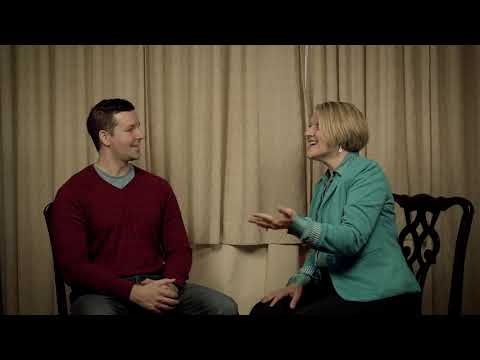The black-and-white video crackles to life. Due to a combination of poor preservation and primitive technology, the picture is gauzy, and the audio is marred by a nagging, sonorous feedback, as if the cameraman decided to film next to the churning engine of a Boeing 747.
Still, the man onscreen is unmistakable. Suit and tie, waistband high, and gray hair perfectly coiffed in a mid-1960s style, he looks like someone who just stepped off the set of I Love Lucy. An esteemed member of psychotherapy’s Pantheon of Heroes, his name has essentially become synonymous with modern clinical hypnosis. This man is Milton Erickson.
It’s 1964, and Erickson, 62, is already a living legend. Despite growing up in a remote Nevada mining town, where he struggled with dyslexia and contracted polio, he became a well-respected psychologist and psychiatrist, researching and using hypnosis at hospitals across the country. His plucky origin story only amplifies the magic and mystery surrounding his unconventional therapeutic wizardry—techniques with names like “hypnotic touch” and “hand levitation”—which is on full display in this recorded demonstration with a stubborn, middle-aged female client who’s worried about pain during an upcoming dental procedure.
“Tell me, have you ever been in a trance before?” Erickson asks the woman. His voice is slow and melodious, like a parent reading a bedtime story to their young child.
“I think so,” she replies.
Erickson smiles and leans forward. “You think so.” He takes the woman’s hand in his, slowly lifting it up. After a few seconds, he lets go. The woman’s hand stays aloft.
“And when do you think you’ll go into a trance for me?” he asks her.
“The way my arm feels, I imagine I might be in one now,” she replies.
Erickson repeats the woman’s words to her slowly, in a tone both questioning and affirming. She nods.
“In what way does your arm feel different?” he asks.
“It tingles,” she replies.
“It’s single,” Erickson says. “It’s apart from you.”
The woman shakes her head. “No,” she replies. “It tingles.”
This time, Erickson puts a little more oomph behind each word: “It’s just plain single.”
“No, no, it tingles. My hand…” The woman stops. “Well, maybe it’s single,” she says. “It doesn’t seem to be so much a part of me as it was before.”
The clinical spell has been cast. Within moments, at Erickson’s suggestion, the woman’s eyes close. Her breathing slows, and her shoulders rise and fall with each breath in and out. Her arm remains raised. After a little back and forth, Erickson asks about the woman’s chronic fear of dental pain.
“I don’t know. I don’t suffer from pain very much,” she replies.
It’s a breakthrough, the kind that would take most clinicians months to achieve. Erickson has done it in just six minutes.
Here, There, and Everywhere
It’s been 43 years since Erickson passed away, but his legacy endures, as does the excitement around hypnosis. The American Society of Clinical Hypnosis (ASCH), which Erickson founded in 1957, has certified tens of thousands of medical and mental health professionals to date. Although only a handful of videos of Erickson performing hypnosis exist today, and most are just minutes long, students have been known to spend hours dissecting them, trying to distill the clinical genius from each word and intonation.
But hypnosis isn’t just a niche practice—or a modern one, for that matter. It boasts a long history, used by Civil War field doctors to treat pain, and by psychologists in both world wars to treat veterans’ neuroses. Benjamin Franklin dabbled in an early version of it while rubbing shoulders with French royalty. It inspired Freud’s development of psychoanalysis. Even the Pope Pius XII gave it his blessing in a 1956 speech at the Vatican.
Today’s practitioners use it to treat a seemingly endless list of psychological and physical ailments, including anxiety, depression, trauma, addiction, insomnia, menopause, obesity, pain during and after surgery and childbirth, and irritable bowel syndrome. It’s been rubber-stamped by healthcare’s biggest names, including the National Institutes of Health, the American Cancer Society, and prestigious university hospitals like those affiliated with Stanford, Johns Hopkins, and the University of Pennsylvania. The American Psychological Association has its own Society of Psychological Hypnosis. The Mayo Clinic considers clinical hypnosis part of its “complementary and alternative medical treatments” that “promote physical, mental, and spiritual wellness,” while others, like the Department of Veterans Affairs, call it an “evidence-based complementary and integrative health approach.”
Speaking of an evidence base, hypnosis has a robust one. Proponents often cite a landmark 1995 meta-analysis published in the Journal of Consulting and Clinical Psychology, which examined 18 studies comparing the effectiveness of cognitive behavioral therapy (CBT) and CBT used in conjunction with hypnosis. The analysis found that clients who received hypnosis alongside CBT had better outcomes than 70 percent of those who received CBT alone. A 2021 follow-up study published in the International Journal of Clinical and Experimental Hypnosis substantiated those findings.
You’d be hard-pressed to find a clinical intervention with more history, applications, endorsements, and sound research. But if hypnosis is so incredible, then why aren’t more therapists using it?
Myths and Misunderstandings
What immediately comes to mind when you hear the word hypnosis? Do you picture a therapist describing a forest scene to their client—the crisp autumn air, dappling sunlight, a gurgling stream, and red and yellow leaves crackling underfoot? Do you imagine a doctor, clad in scrubs and crouching beside a patient being prepped for surgery, describing the feeling of featherlike weightlessness, of sinking into hibernation? Or do you think of a sleep specialist describing what it feels like to slide under the covers as the pillow slowly molds itself to the contours of your head?
Maybe you picture something else, like swinging pendulums, hypnotic spirals, or carnival barkers. Or perhaps a manipulative Svengali, vocally puppeteering hapless, glassy-eyed men and women who’ve surrendered complete control of their minds and bodies.
If you answered yes to the latter, you’re not alone. Clinical hypnosis may be a legitimate practice, but it suffers from its associations and caricatures. It’s something Erickson recognized early on. As a boy, he witnessed a traveling performer demonstrate hypnosis. A few years later, while bedridden from polio, he began to notice and study his family members’ vocal tones, body language, and facial expressions, and the role they played in influencing thoughts and behavior. The ability to harness these subtle elements of communication to elicit a desired effect piqued his interest in the medical applications of hypnosis. It was a power too great, he said, to be left to entertainers.
But despite its advancements and accolades, hypnosis’s negative associations persist. Some people believe clients under hypnosis lose control or consciousness. Others believe it can improve recall or uncover hidden memories, an ability known as hypnotic hypermnesia. In reality, says therapist Courtney Armstrong, who does hypnosis trainings for the Department of Veterans Affairs, the way hypnosis operates is actually quite undramatic.
“Hypnosis is simply a state of absorbed, focused attention,” she explains. “It’s using language to create suggestions as a way of following up on something the client may want to do that we’ve discussed in therapy. It’s using stories and metaphors to create a sensory experience that reaches below the rational, cognitive mind and into the subconscious mind, or emotional brain—the part that needs an experience to change. The therapist might say something like, ‘You’re on the beach, and you can feel the warm sun on your face and smell the coconut in the air.’ It’s experiential learning that gets you into a state for your brain to learn a new pattern.”
But what about losing control or consciousness? “When you’re hypnotized, you’re in full control of the experience,” Armstrong explains. “Hypnosis is collaborative, and you can’t do it unless you want to. The therapist is merely a guide, and the best hypnosis is personalized. I ask the client beforehand ‘Where do you want to go today?’ If they say, ‘the beach,’ I’ll ask what they like about it. I’ll use their descriptions and words and imagery, because not only will it resonate more that way, but I’ll avoid anything potentially triggering. We’ll collaborate beforehand to find out what they’re comfortable with and what experience they want to have. So they get to choose. They can ignore anything I say that doesn’t resonate, and they can stop the process at any time.”
Yes, you do enter a dissociated state in hypnosis, Armstrong adds, but not in the pathological sense. She compares it to getting lost in a good book or movie, to being so absorbed by an experience that you’re able to tune out distractions like competing thoughts and sensations. Someone may call your name, for example, and you may not hear it. You’re not losing consciousness or your identity, Armstrong says, “you’re just so into the experience that you’ll feel like you’re someplace else.”
Therapist Michael Yapko, who’s been practicing hypnosis for more than 50 years and has written extensively about it, scoffs at the notion that clients under hypnosis would lose control. “What’s fascinating about hypnosis is that it actually increases people’s control over their symptoms,” he says. Because common problems like anxiety, depression, and physical pain feature a disruption of focus, it makes sense to use an intervention that helps people relax, so they can regain focus and then develop skills to address their symptoms. For many clients, the resulting feelings of tranquility, alertness, and agency are sensations they haven’t felt in a long time—which boosts their confidence and propels treatment forward.
“Hypnosis often generates immediate changes,” Yapko says. “The client might start off anxious, but 15 minutes into hypnosis, their breathing slows down, their body relaxes, and their anxiety diminishes; and they now have direct, concrete evidence that their symptoms are malleable. It’s why hypnosis enhances virtually every form of treatment.”
Liabilities and Bad Apples
It’s not just nontherapists who get hypnosis wrong. Many clinicians—even some who identify as hypnosis practitioners—reinforce myths and misunderstandings, like the notion that hypnosis is the therapy, rather than just a delivery system for it—which Yapko considers the most misunderstood aspect of hypnosis practice. “When you go to a hypnosis training, you’re not learning a whole new approach to treatment,” he explains. “You’re learning how to do your treatment better. Hypnosis is a vehicle for existing modalities, a way of introducing ideas and perspectives.”
Another common misunderstanding among clinicians is the idea that hypnosis is a process that only occurs within the client, rather than one that also transpires between the client and therapist—“the hypnotic relationship,” as Yapko calls it.
But perhaps the most divisive misconception in clinical circles deals with the issue of memory recall. In the mid-1990s, hypnosis was dragged into a raging debate about whether repressed traumatic memories exist (and if so, whether they could be uncovered), as well as whether traumatic memories are subject to manipulation. Although using hypnosis to recover memories has since been largely debunked, the issue divided—and continues to divide—the psychotherapy field.
Why do these misunderstandings occur? A combination of factors is to blame, Yapko says. Notably, there isn’t an official licensing or credentialing organization for hypnosis. Each state sets its own requirements for practicing hypnosis, and generally, a license to practice therapy is all that’s needed. Some trainings, like those offered by Yapko, Armstrong, and ASCH, involve multitiered weeks of study. But in some states, like Tennessee, where Armstrong practices, there are no laws prohibiting someone from taking a weekend workshop and then calling themselves a hypnosis practitioner.
“It’s unfortunate that the people who are serious about doing hypnosis get painted with the same brush as people who take very short trainings and think they’ve learned something about hypnosis,” Yapko says, noting that hypnosis suffers from the same problem as any intervention: not everyone who practices it will bother to get properly trained, and some will overestimate or overpromise what it can do.
That’s not accounting for the fact that hypnosis, like all therapy, may look very different between two very capable providers. “You could watch a hundred CBT therapists,” Yapko says, “and they’d all be doing different versions of what they consider CBT, so someone using the umbrella label of hypnosis doesn’t really tell you much about what they’re actually doing. When people get trained, they’re encouraged to find their own voice.”
Is the lesson here, as it so often is when looking for a provider, simply caveat emptor—buyer beware? With so much misinformation floating around, and so much differentiation among providers, how can anyone know whether the hypnosis treatment they’re getting is sound? At the end of the day, what not only makes for an authentic hypnosis session, but a great one?
Taking the Plunge
Looking for the answers to those questions is exactly how I found myself waving hello through my webcam to therapist Shawn Criswell, gearing up to do my very first hypnosis session. Criswell, one of Yapko’s former students, has been doing hypnosis for decades. Initially, we’d just planned on doing an interview for this article. But at the start of our chat, she asked if I’d ever done hypnosis. I hadn’t. Toward the end, she asked if I wanted to do hypnosis. I had some trepidation. What might bubble to the surface? I wondered. Still, I knew I’d be in good hands. Criswell is friendly and thoughtful and knows her stuff. Plus, she’s endearingly persistent. Finally, I acquiesced.
Before getting started, Criswell helps me get oriented. We’re about to do a hypnosis exercise called Accessing and Contextualizing Resources, she tells me. Calming resources, she says, whether it’s reading a good book or watching a sunset with a partner, exist naturally in everybody. She asks what one of mine is, and I tell her: a walk in the woods. But for me, being alone in nature, in silence, also leaves space for intrusive thoughts—big ones, about life purpose, or time, or growing older. “They’re not bad thoughts,” I explain, “but they do detract from the experience.”
“So it sounds like you might enjoy being able to more naturally modulate the percentage of you that’s going to those thoughts?” she asks. “Almost like a dimmer switch?”
Exactly like a dimmer switch.
After checking my alertness on a scale of one to 10 (I’m at a seven—“the perfect starting point,” Criswell says), we begin.
“Notice your breath,” she says. Her voice is soft, slow, and mellifluous, hardly above a whisper. “Notice your body.” I close my eyes, and my head tilts down. The ends of her sentences—words like woods, and space, and birds, and trees—fade into the beginnings of the next ones, like she’s slowly turning a volume knob down to zero, and then slowly back up.
“You already know how to modulate your attention in an interview,” she says, adding a personal touch. “There are so many thoughts. And you can be aware of those thoughts in an amused way. Maybe one thought sits in a chair over there. And another thought you put on a treadmill so it can get its energy out. And just take a breath, because you can.” I oblige. “As your body moves through the woods,” she continues, “slow down a thought and create distance from it. Or assign it a task. So many possibilities. So many experiences to explore.”
Criswell and I continue like this for 17 minutes. She paints beautiful woodland scenes. She gently directs me to check in with my body, and when I notice tension getting in the way, like in my folded hands, I lay them flat on my thighs and return to the forest in my head. When my neighbors in the apartment next to me slam their front door and begin to chatter in the hallway, she gives me permission to recognize it, and then return my attention back whenever I’m ready. She weaves in personal details, like stories I’ve written, and the cross-country road trip I took three years ago, and the old college professor I recently reconnected with—things I mentioned in passing on our first call and am frankly amazed she, or anyone, would remember. Criswell isn’t just skilled. She makes it feel like she knows me, like she cares.
“Now the Zoom clock is telling me that our time is drawing to a close,” Criswell says. “And so you can bring forward with you anything that’s with you to access and practice later.” Her voice begins to return to normal volume. “So, coming back now,” she says. “Eyes open, alert, awake, and here on Zoom!”
I’ve never been to a spa, but I imagine this is what it must feel like. I feel rejuvenated. I feel sharper, more alert, and calmer than I did 17 minutes ago. A part of me feels like maybe I can be kinder to myself, more forgiving when my thoughts begin to wander—at least for now. Maybe I’m even a little more mindful. A few hours later, at my father’s piano recital—and still buzzing from my hypnosis session—I begin to notice my focus drifting, and then gently shift it back to the music.

We’ve come a long way since the days of Erickson, but there are still plenty of unanswered questions about how and why hypnosis works. Why are some people more responsive to it than others? Are there differences between the brains of people who respond to hypnosis and those who don’t? How is it that a person can feel someone pinch them, but that same person under hypnosis won’t feel a needle or scalpel? “When you find the answers to those questions,” Yapko tells me, “go to Stockholm and pick up your medal.”
After experiencing it personally, I have no doubt that a large part of what makes hypnosis—or any therapy, for that matter—so effective is the presence of a fellow explorer, someone who not only holds a mirror to your inner world, but slows everything down and joins you in processing whatever’s reflected back. It may not be magic, but I’ll take it anyway.
ILLUSTRATION © ISTOCK.GOLUBOVY
Chris Lyford
Chris Lyford is the Senior Editor at Psychotherapy Networker. Previously, he was assistant director and editor of the The Atlantic Post, where he wrote and edited news pieces on the Middle East and Africa. He also formerly worked at The Washington Post, where he wrote local feature pieces for the Metro, Sports, and Style sections. Contact: clyford@psychnetworker.org.













